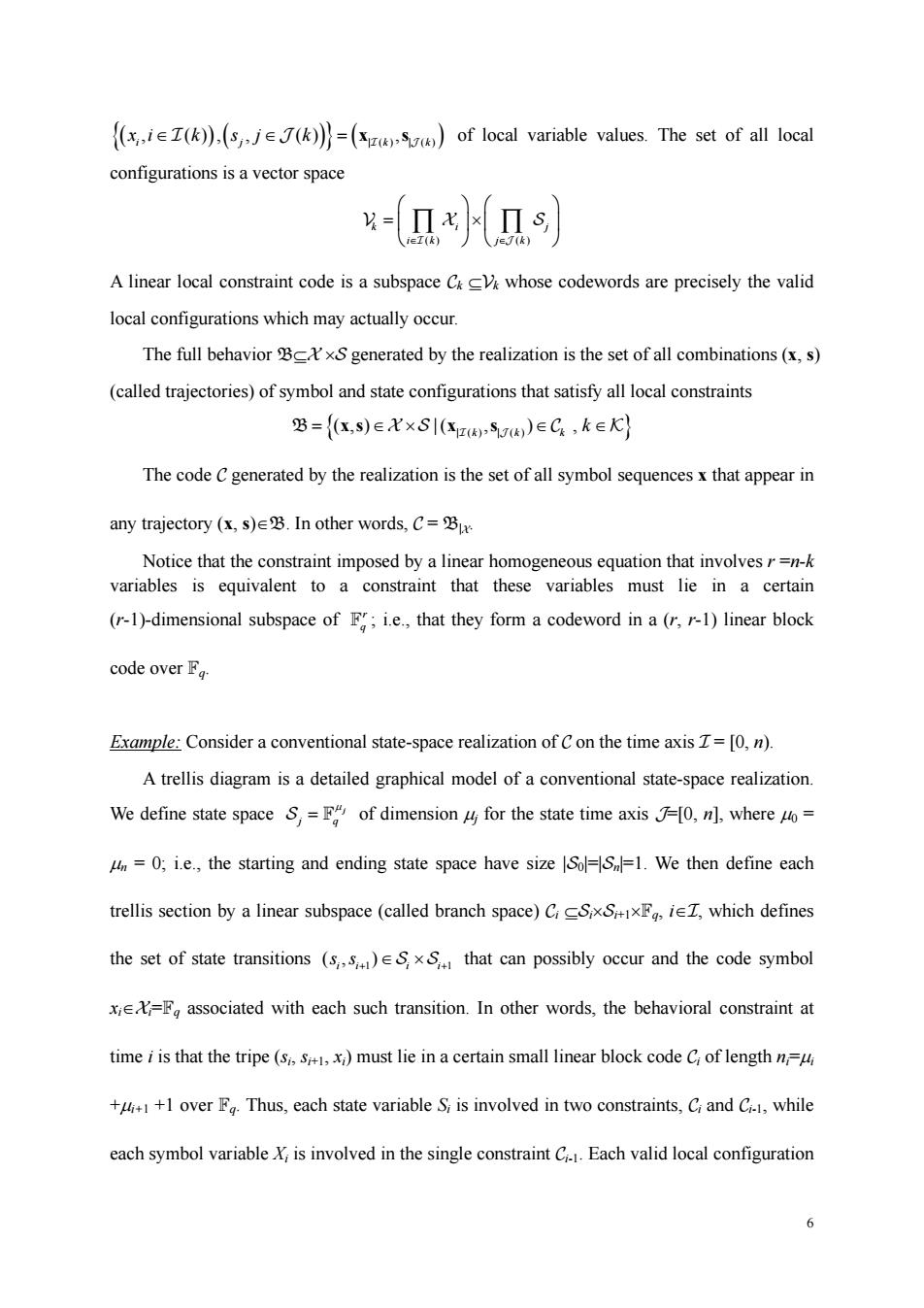正在加载图片...

(i().(sj(k)=()of local variable values.The set of all local configurations is a vector space -(Lx几 A linear local constraint code is a subspace C whose codewords are precisely the valid local configurations which may actually occur. The full behaviorBS generated by the realization is the set of all combinations(x,s) (called trajectories)of symbol and state configurations that satisfy all local constraints 2B={L,s)eX×SI(zv)eC,k∈K The code Cgenerated by the realization is the set of all symbol sequencesx that appear in any trajectory(亿,s)eB.In other words,C=Be Notice that the constraint imposed by a linear homogeneous equation that involvesr=n-k variables is equivalent to a constraint that these variables must lie in a certain (r-1)-dimensional subspace of F;i.e.,that they form a codeword in a(r,-)linear block code over F Example:Consider a conventional state-space realization of Con the time axis I=[0,n). A trellis diagram is a detailed graphical model of a conventional state-space realization We define state dimension for the state time =0;i.e.,the starting and ending state space have size So==1.We then define each trellis section by a linear subspace (called branch space)CFi,which defines the set of state transitions (s)xthat can possibly occur and the code symbol x,Fassociated with each such transition.In other words,the behavioral constraint at time i is that the tripe (s)must lie in a certain small linear block code Cof lengthn ++1 over F Thus,each state variable S,is involved in two constraints,C and C while each symbol variableX is involved in the single constraint C.Each valid local configuration6 {( ) ( )} ( ) |() | () , (), , () , i j kk xi k s j k ∈ ∈= x s I J I J of local variable values. The set of all local configurations is a vector space () () ki j ik j k ∈ ∈ ⎛ ⎞⎛ ⎞ = × ⎜ ⎟⎜ ⎟ ⎝ ⎠⎝ ⎠ ∏ ∏ I J VX S A linear local constraint code is a subspace Ck ⊆Vk whose codewords are precisely the valid local configurations which may actually occur. The full behavior B⊆X ×S generated by the realization is the set of all combinations (x, s) (called trajectories) of symbol and state configurations that satisfy all local constraints B = ∈× ∈ ∈ {( , ) | ( , ) , xs x s XS C K | () | () I J kk k k } The code C generated by the realization is the set of all symbol sequences x that appear in any trajectory (x, s)∈B. In other words, C = B|X. Notice that the constraint imposed by a linear homogeneous equation that involves r =n-k variables is equivalent to a constraint that these variables must lie in a certain (r-1)-dimensional subspace of r F q ; i.e., that they form a codeword in a (r, r-1) linear block code over Fq. Example: Consider a conventional state-space realization of C on the time axis I = [0, n). A trellis diagram is a detailed graphical model of a conventional state-space realization. We define state space j j q μ S = F of dimension μj for the state time axis J=[0, n], where μ0 = μn = 0; i.e., the starting and ending state space have size |S0|=|Sn|=1. We then define each trellis section by a linear subspace (called branch space) Ci ⊆Si×Si+1×Fq, i∈I, which defines the set of state transitions 1 1 (, ) ii i i s s + + ∈ × S S that can possibly occur and the code symbol xi∈Xi=Fq associated with each such transition. In other words, the behavioral constraint at time i is that the tripe (si, si+1, xi) must lie in a certain small linear block code Ci of length ni=μi +μi+1 +1 over Fq. Thus, each state variable Si is involved in two constraints, Ci and Ci-1, while each symbol variable Xi is involved in the single constraint Ci-1. Each valid local configuration